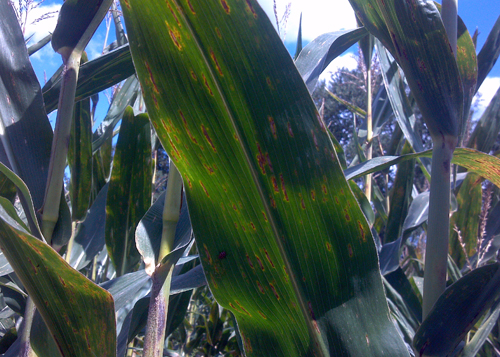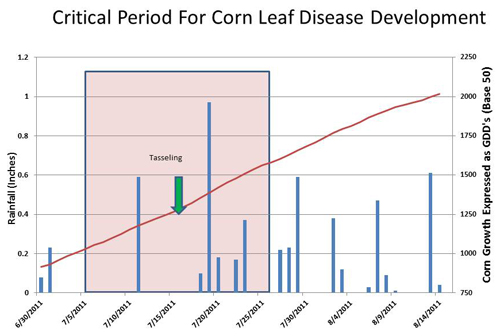Are we at increased risk of yield losses due to corn leaf diseases in southwest Michigan in 2012?
What to consider as you weigh whether fungicide applications are necessary in your field this year due to increases in gray leaf spot and northern corn leaf blight.
We have been seeing increased incidence of the corn leaf diseases gray leaf spot and northern corn leaf blight in southwest Michigan corn fields in 2010 and 2011. Gray leaf spot is a fungal disease that is caused by the pathogen Cercospora zeae-maydis. The pathogen does well in years when the average temperatures are above normal (75-85°F), lots of rainfall for extended periods of time and high relative humidity. Initial symptoms of gray leaf spot appear as small, brown to grayish lesions that have a yellow halo around them. The lesions are often contained between leaf veins, giving infected leaf tissue a checked gray rectangular appearance. Lesions can infect significant percentages of leaf tissues. The disease gets a foothold in the later vegetative growth stages and can threaten yields if it becomes established early enough to cause loss of photosynthetic capacity of the upper leaves during grain fill.

Gray leaf spot.
Northern corn leaf blight is caused by the fungal pathogen Exserohilum turcicum. Like gray leaf spot, the disease overwinters in infected corn stalks. However, the optimal temperature for northern corn leaf blight infection is slightly cooler at 65-75°F, and requires extended periods of leaf wetness.
Both of these pathogens were seen in increasing numbers of fields of commercial corn in 2010 and 2011. Some factors that might be influencing the increased incidence include more corn following corn acres in production, which increases the amount of inoculum in fields. Gray leaf spot incidence has most likely been helped by the warm temperatures during 2010 and 2011. Whatever the reason, more fields are approaching treatable thresholds for these diseases during the growing season. Around 40 percent of the plots planted in 2011 at the Cass County Corn Variety Performance Trial showed signs of significant leaf tissue damage from these diseases. Most of the tissue damage appeared to occur later in the season. However, when you look at the weather conditions at the site in 2011, you can see that the weather most conducive to disease development (July 18-30) occurred after tasseling (around July 13), with frequent rainfall events. The concern is that with increasing incidence, we are setting the stage for a significant disease outbreak this coming year if warm, wet conditions happen to occur during the late vegetative growth stage through early grain fill. We are going to be monitoring corn leaf disease development in 2012 at the Cass County MSU Corn Variety Performance Trial funded by a Project GREEEN grant.

So, how can you decide if your field would benefit from a fungicide application? Scouting for these leaf diseases should occur as the corn reaches the later vegetative growth stages. Some factors to consider in making a fungicide application decision are listed below.
- For susceptible or moderately susceptible varieties, consider a fungicide application if 50 percent of the plants in the field have gray leaf spot lesions present on the third leaf below the ear leaf or higher prior to tasseling.
- For moderately resistant varieties, consider a fungicide application if 50 percent of the plants in the field have gray leaf spot lesions present on the third leaf below the ear leaf or higher prior to tasseling, and weather conditions are forecasted to be wet and moderate to warm temperatures.
- Scout resistant varieties for gray leaf spot disease, but in general, resistant varieties do not benefit from a fungicide application.
Currently, there aren’t any specific spray thresholds for northern corn leaf blight, but this disease can cause yield loss, particularly when disease is observed on the ear leaf. Consider weather conditions, past disease history, corn debris and economics when deciding whether to spray.
Research that has been conducted by several land grant universities across the Corn Belt have indicated that, in most instances, a single application of a fungicide at tassel emergence (Vt) has been the most profitable. Keep in mind, however, that fungicide applications will only increase yields if the diseases are present at levels to impact yields.
Additional information
- Diseases of Corn: Northern Corn Leaf Blight, Purdue University Extension
- Diseases of Corn: Gray Leaf Spot, Purdue University Extension



 Print
Print Email
Email


